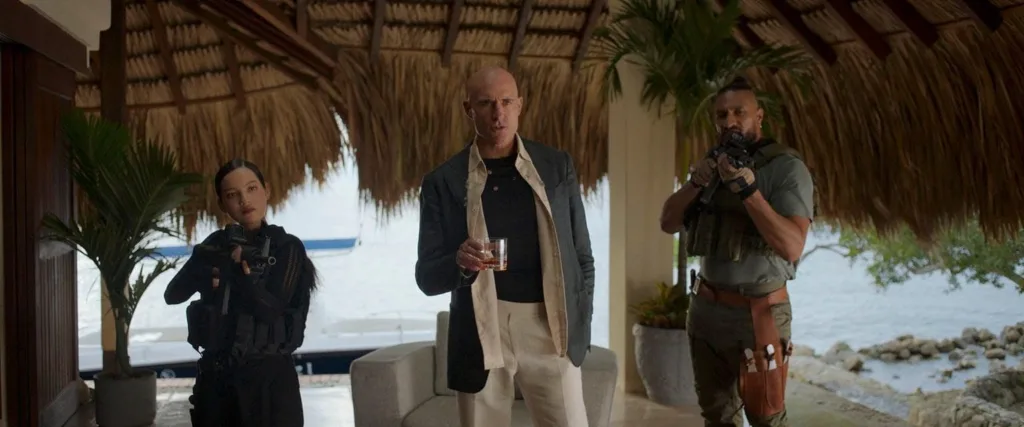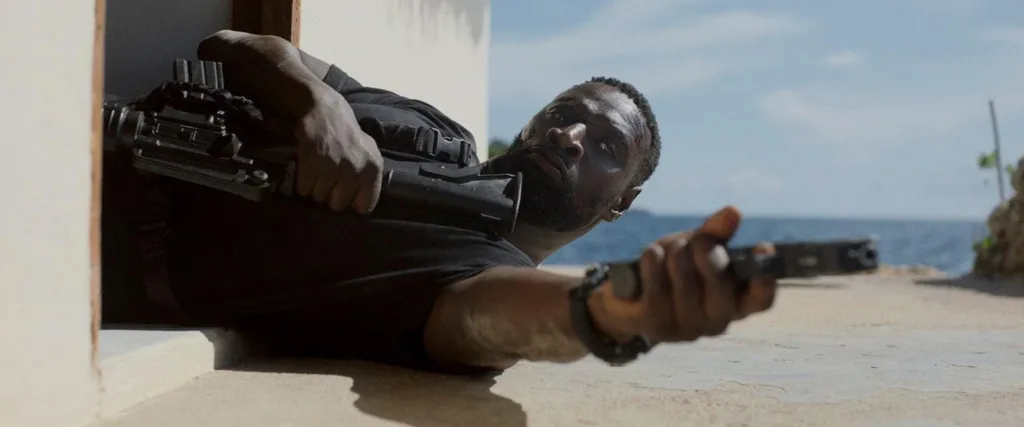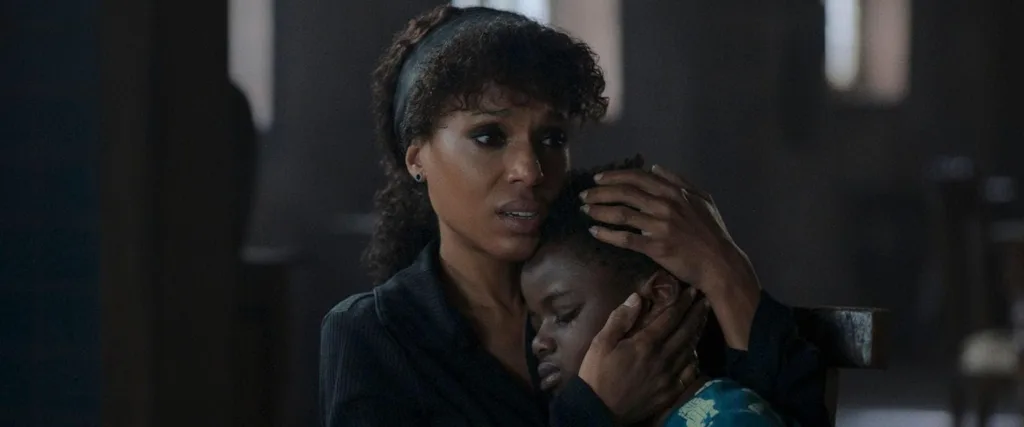At the outset, Shadow Force positions itself as a portrait of exile and allegiance: ex‑shadow operatives turned family on the run (one sentence logline). It wears the trappings of a high‑stakes spy thriller—gunmetal skies, clandestine radio chatter—yet pulses with the quiet anxieties of domestic drama.
Joe Carnahan—whose résumé boasts Smokin’ Aces and Boss Level—returns to familiar territory, trading gritty grain and blown‑out hues for a muted palette that feels less “artistic choice” than “entirely color‑blind” (an occasional downside of modern streaming aesthetics given theatrical release). Kerry Washington anchors the film as Kyrah, a mother driven by equal parts ferocity and guilt; Omar Sy’s Isaac pairs paternal warmth with calibrated lethality; and Mark Strong’s Jack Cinder looms as a cynical patriarch of bureaucracy and bullets.
The opening tableau is deceptively serene: Isaac teaching five‑year‑old Ky to hum Lionel Richie (yes, really) while storing a suppressed pistol under his jacket reminds us that even lullabies carry echoes of violence. A single bank‑robbery sequence shatters this idyll, smoke‑bomb plumes merging with childhood innocence in what one might call “parental warfare” (a new term for ambivalent heroism).
Here, love and parenthood collide with secret‑service obligations—a paradox as old as the nuclear family itself. The true question isn’t who will survive, but how a couple forged in shadows can reclaim light without losing each other.
Blueprint of Exile
From the outset, Shadow Force scripts a dual origin story: Isaac’s pastoral routine—teaching five‑year‑old Ky a Lionel Richie refrain—belies his lethal past. This quiet tableau (think Cold War sleeper‑cell lullabies) establishes both sanctuary and foreshadowing: no refuge remains when love is deemed treachery.
Their backstory unfolds in flashback vignettes: two covert operatives collide in combat and succumb to an even fiercer impulse—affection. By breaking Shadow Force’s cardinal rule (“no attachments”), they enact a micro‑revolution against institutional dehumanization. Such domestic dissent evokes real‑world whistleblowers whose personal ethics outpace bureaucratic edicts.
Then comes the inciting blast: Isaac neutralizes armed robbers in a hail of bullets. A bank‑surveillance camera becomes a panopticon, exposing him and Ky to the agency’s omniscience (welcome to the modern surveillance era). Instant jeopardy follows: a digital footprint morphs into a death warrant.
In the rising action, the family reunites deep in the Colombian jungle, a metaphorical no‑man’s‑land where parental guilt and guerrilla tactics merge. Kyrah’s resentment simmers—protecting family by staying away seems noble until it feels like self‑punishment. Enter “Auntie” and “Unc,” whose off‑kilter humor (Method Man dropping one‑liners like landmines) provides respite in a “familial fugue” of violence and affection.
The climax erupts on Cinder’s island fortress, a contemporary siege echoing medieval keeps. Speed‑boat chase and claustrophobic firefight converge, parents improvising asymmetric defenses to shield Ky. The resolution (or stalemate) leaves the agency wounded but not vanquished, much like failed empires that clutch at revenge. The film’s emotional coda—Isaac cradling Ky amid ruined battlements—reaffirms that the most formidable fortress is the heart.
Anatomy of Allegiance
Kerry Washington’s Kyrah Owens embodies what I’d call “maternal ironclad”—a force as unyielding as any military-grade exoskeleton (her hand‑to‑hand prowess is a neat metaphor for breaking norms with bare knuckles). She shifts from lone hunter—one who haunts her own conscience—to co‑defender of hearth and home, a journey that mirrors historical tales of political exiles forging new allegiances. Yet her occasional leaps in logic (why wait, Kyrah?) suggest an overreliance on tearduct activism, as if tears were tactical weapons.
Omar Sy as Isaac Sarr offers counterpoint: warmth cloaked in lethal efficiency. His discomfort with violence recalls veterans haunted by collateral damage—though here the collateral is paternal guilt. Isaac’s Lionel Richie obsession (yes, that Lionel Richie) functions as both comic relief and sonic tether to innocence. One moment, he’s a stoic protector; the next, a doting dad singing “Hello” to stave off trauma. It’s a delicate balance between gravitas and goof—sometimes it lands, sometimes it feels like tonal whiplash. Still, his arc of reclaiming confidence (from PTSD to PHTTPD: Post‑Traumatic “Happy Track” Disorder) rings surprisingly honest.
Mark Strong’s Jack Cinder is the archetypal “institution incarnate,” a scorned ex‑boss turned geopolitical functionary. His vendetta against love-as-treason echoes McCarthy‑era purges—personal grudges elevated to policy. Strong chews scenery with gusto, though the screenplay rarely gifts him nuance beyond “Generic Baddie 2.0.”
Then there’s Ky (Jahleel Kamara), the child’s-eye philosopher—innocence set against a fusillade of bullets. His wide‑eyed reactions serve as ethical compass: he asks why a dad must kill to protect him, a question that unites mythic family dramas across epochs.
“Auntie” and “Unc” (Da’Vine Joy Randolph, Method Man) inject “familial fugue,” their banter reminiscent of refugee‑camp camaraderie (finding laughter amid chaos). They lighten the tempo while underscoring that extended kinship can be as vital as blood ties.
The rest of the Shadow Operatives? Visual flourishes in tactical garb—obstacles rather than characters. They exist chiefly to punctuate set pieces, functioning as kinetic punctuation marks in this fugitive’s manifesto.
Palette of Paradox
Joe Carnahan trades his usual blown‑out grit for a muted spectrum, as if moral ambiguity had its own color code. The quick‑cut editing feels like rapid‑fire news alerts—an aesthetic born in our age of information overload—while his signature framing (characters half‑shadowed, faces caught in chiaroscuro) suggests that identity itself is under surveillance.
Juan Miguel Azpiroz’s lens leans heavily on greys and desaturated blues, punctuated by plumes of smoke that blur action into abstraction (what I’d call “conflict impressionism”). Shooting in the Colombian jungle conjures guerrilla‑war reportage, while the island fortress evokes Cold War exile camps—both spaces of entrapment and illusion.
Wide‑angle vistas show nature reclaiming abandoned hide‑outs, then snap to tight close‑ups when Isaac or Kyrah confronts trauma. This contrast underscores a central tension: the vastness of the world versus the claustrophobia of hiding. In one sequence, a silent jungle canopy encloses the family like a courtroom—nature as judge and jury.
Production design splits the world in two. Domestic interiors glow with soft amber light and textured fabrics (a womb threatened), whereas operational zones sparkle with steel, neon glints, and clinical detachment. Even the weaponry is utilitarian—no gadgetry fanfare, just cold metal that feels weighty in the hand (a nod to cinema’s waning appetite for James Bond‑style toys).
There are flashes of visual bravado—a speed‑boat chase slicing through twilight—but too often these beats play against generic backdrops, as if the film feared stylistic excess. Still, when the palette and framing align with the narrative’s emotional stakes, the result is a kind of visual tautology: form mirroring fractured family bonds.
Mechanized Ballet of Mayhem
The bank‑robbery rescue erupts with strobe‑light intensity, each flash a heartbeat in a high‑tech battlefield. Isaac’s limbs become weapons in close‑quarters combat (think urban samurai, if samurai had body armor). The choreography here feels like a commentary on our surveillance age: every move is lit, recorded, judged.
Hand‑to‑hand scenes lean on raw athleticism. Washington and Sy show genuine grit, though their martial‑arts flourishes sometimes teeter into “stylish struggle”—impressive, yet occasionally opaque in motivation.
A mountain‑road chase follows, geography as antagonist. Tight bends and sheer cliffs amplify tension: it’s kinetic theatre, where nature itself conspires against the protagonists. Then comes the speed‑boat finale: waves crashing, engines roaring. The sequence holds its own until geography recedes into generic watery backdrop, the stakes felt rather than seen.
Carnahan’s commitment to practical stunts (no green‑screen sorcery) gives the film a tactile quality. You sense the actors’ weight, the engine’s roar vibrating through the frame. Reality jostles cinematic hyperbole—a duality reminiscent of 20th‑century war correspondents who filmed tanks rolling through villages.
Smoke bombs introduce what I’ll dub “optic obfuscation”: veils of grey that both stylize and confuse. Are we watching an action set‑piece or a diptych on obscured truths? Bullet‑spray choreography becomes ritualized punctuation, each tracer line an exclamation point in this visual manifesto.
In comparison to the “John Wick” school of hyper‑precision, Shadow Force aspires to measured brutality but sometimes lapses into boilerplate. Unique angles surface here and there—a guerrilla‑style ambush or a guerrero’s guerrilla tactics—but clichés still crop up like weeds in the underbrush of its more inventive moments.
Fires of Fidelity
At its core, Shadow Force stages a perennial tug‑of‑war: parental love versus professional duty. Kyrah’s “mamma‑bear” ferocity isn’t mere spectacle—it channels ancient myths of maternal guardianship (think Demeter searching for Persephone) reframed in tactical gear. Isaac’s protective instinct, meanwhile, echoes soldiers who desert battlefields to return home—only here, home is a jungle hide‑out rather than a village church.
Love becomes an act of insurrection. Shadow Force’s strict no‑attachments policy reads like Orwellian thought‑crime: to care is to rebel. Kyrah and Isaac pay a steep toll for their affection, sacrificing anonymity and safety for Ky’s sake. It’s reminiscent of Cold War defectors whose personal loyalties overrode national loyalties, forging new identities at immense personal cost.
Betrayal weaves through every firefight. Former comrades morph into hunters, illustrating how institutional allegiance can cannibalize humanity. Yet within the nuclear family, trust binds tighter than any chain of command; their unity offers a counter‑narrative to societal atomization, suggesting that chosen bonds might outlast forced hierarchies.
Living under assumed identities, the parents grapple with reinvention—actors perpetually switching masks. Their struggle mirrors migrants adapting to foreign lands: past selves both mourned and dismissed. In this restless quest for normalcy, Shadow Force asks: when duty and desire clash, what remains of the self?
Full Credits
Director: Joe Carnahan
Writers: Joe Carnahan, Leon Chills
Producers: Kerry Washington, Pilar Savone, Stephen “Dr” Love, Sterling K. Brown
Executive Producers: K. Blaine Johnston, Christopher Woodrow, Jennifer Wiley-Stockton, B. Quinn Curry, Danielle Reardon
Cast: Kerry Washington, Omar Sy, Mark Strong, Da’Vine Joy Randolph, Cliff “Method Man” Smith, Jahleel Kamara, Marvin “Krondon” Jones III, Natalia Reyes, Yoson An, Ed Quinn, Jénel Stevens-Thompson, Marshall Cook
Director of Photography (Cinematographer): Juan Miguel Azpiroz
Editors: Kevin Hale, Mike Sale
Composer: Craig DeLeon
The Review
Shadow Force
Shadow Force offers just enough emotional heft to lift it above routine spy fare, anchored by Washington and Sy’s genuine rapport and Carnahan’s atmospheric framing. Though action clarity sometimes collapses under smoke and quick cuts, its meditation on family as an act of rebellion lingers beyond the final gunshot. Not revolutionary, yet an intellectually playful thriller that values heart over hyperbole.
PROS
- Kerry Washington and Omar Sy’s chemistry brings genuine warmth
- Thoughtful tension between parental love and covert duty
- Muted, atmospheric visuals that underscore moral ambiguity
- Practical stunts and minimal CGI lend tactile realism
- Dry humor (courtesy of “Auntie” and “Unc”) lightens the tone
CONS
- Action clarity sometimes suffers under smoke and rapid cuts
- Secondary villains lack depth beyond generic menace
- A few plot beats hinge on questionable character choices
- Tonal shifts between drama and levity can feel uneven
- Familiar genre tropes rarely feel reinvented




















































